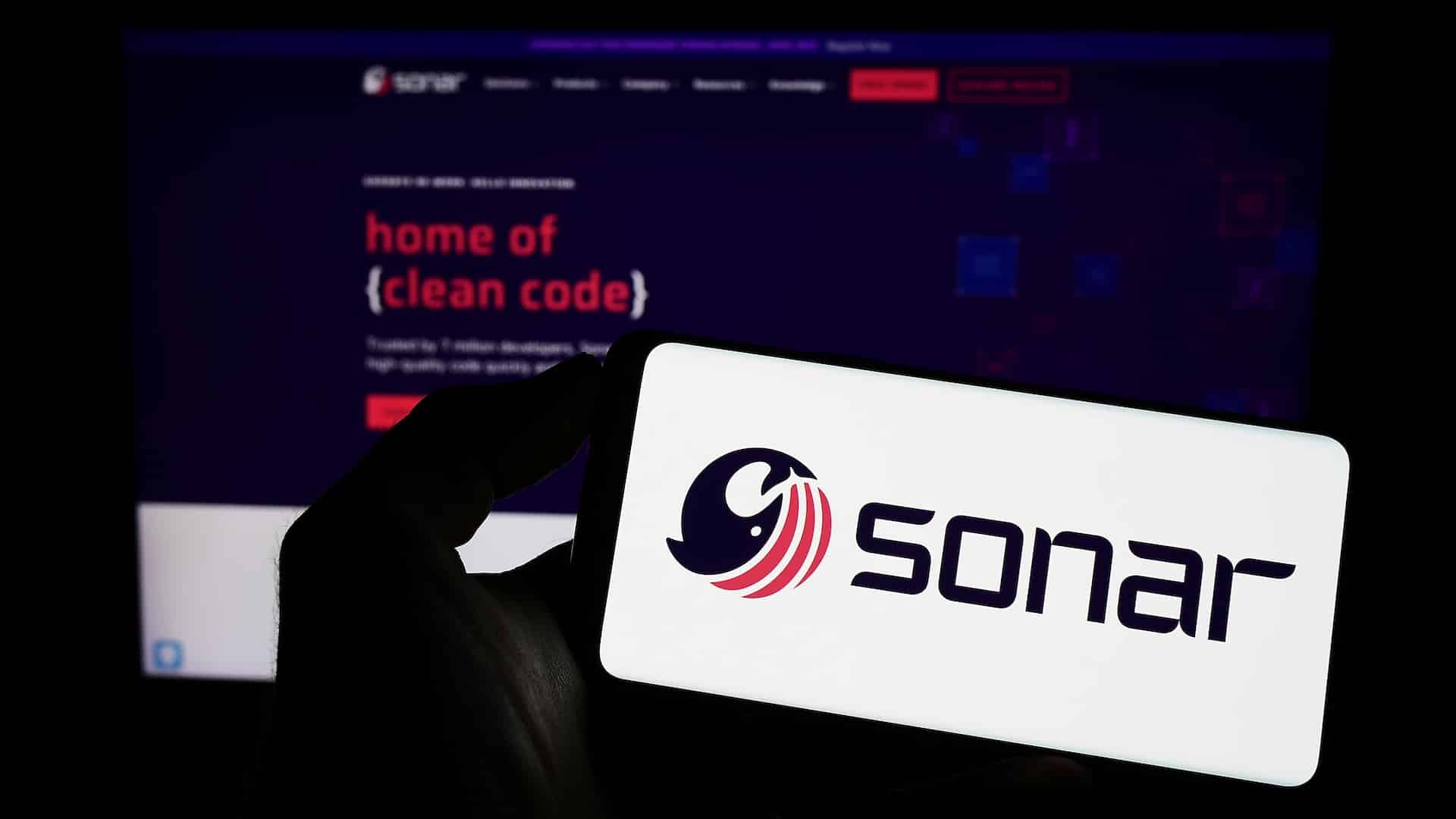In the digital age, web application performance is a key success factor for any organisation. Users in the modern world expect a smooth, fast and reliable experience, whether they’re browsing an e-commerce site, using a SaaS application or interacting with online services. According to studies, a response time of more than three seconds can result in a significant loss of users. If an application is slow or interrupted, it doesn’t just affect the user experience: it can also damage a company’s reputation and lead to financial losses.
This is where performance testing comes in, a crucial step that goes far beyond simple functional checks. Unlike traditional tests, which are designed to ensure that the application “works”, performance testing is aimed at guaranteeing that it runs in optimal fashion, even under difficult conditions. The tests measure critical aspects such as application speed, stability, scalability and resilience.
This article will guide you through the basics of performance testing: what it entails, why it’s essential, and how to implement it so as to meet user expectations while ensuring the longevity of your systems. We’ll also explore the different types of testing, the tools available, and the steps needed to make the most of this essential approach. Finally, we’ll look at how to react if the results reveal weaknesses, so as to transform these challenges into opportunities for improvement.
Overview
What is performance testing?
Performance testing is a series of software tests designed to evaluate an application’s behaviour in terms of speed, stability and scalability under different workloads. It’s not just a question of knowing whether an application works, but of measuring precisely how it performs under real-life or extreme conditions.
Main objectives:
- Identify bottlenecks: Detect parts of the system that slow down performance, such as slow requests or saturated resources.
- Ensure stability: Check that the application remains functional and responsive even in the event of high demand or an unexpected load.
- Improve user experience: Guarantee fast, consistent response times, to prevent users from getting frustrated and abandoning the application.
- Validate infrastructure: Ensure that servers, databases and other components are correctly configured so as to meet performance requirements.
Key metrics monitored:
- Response time: The time required to respond to a user request.
- Resource usage: CPU, memory and bandwidth consumption.
- Throughput: The number of transactions or requests processed per second.
- Error rate: The number of failed requests under a load.
When should a performance test be carried out?
Performance testing should be carried out at strategic points in an application’s lifecycle, to ensure that it meets user expectations and technical requirements.
Critical steps in performance testing:
- Before going into production
Launching an application without doing any performance testing is risky. This type of testing allows you to anticipate problems before they affect end-users. - After major upgrades
Every code modification, feature addition or infrastructure change can impact performance. Testing after each update ensures that you maintain the same level of quality. - During marketing campaigns or special events
If we take an e-commerce site as an example, the site may experience traffic peaks during the sales. Testing ahead of these events helps prevent breakdowns or slowdowns. - Periodically
Regular testing enables you to conduct long-term monitoring of performance and identify problems before they become critical.
The different types of performance testing
Performance testing encompasses several types of test, each with its own specific objectives. Here’s an overview of the most common ones:
The average load test
The average load test evaluates how the system reacts to a normal or slightly elevated load.
Case study:
An online ticket booking site needs to support 5,000 users at the same time. Using a load test, you can check that the response time remains acceptable for each user.
Peak load test
Peak load testing consists of running target test cases that simulate the maximum number of connected users expected in peak load situations.
Case study:
A banking application experiences a heavy load at the beginning of each month. Using a peak load test, you can check that the response time remains acceptable for each user.
The stress test
Stress testing pushes the application to its limits, with the aim of quickly reproducing a performance bottleneck.
Case study:
Simulate 20,000 simultaneous users on a server designed to handle 10,000. This allows us to see whether the system completely collapses or continues to operate in degraded mode.
Scalability testing
Scalability testing involves running the target test cases under an increasing load, to identify the breaking point at which you start dropping requests or response times (RTs) no longer meet the requirements.
Case study:
Estimating the maximum load that a web application can support
The robustness test
Robustness testing, also known as resilience testing, assesses a system’s ability to continue operating despite failures or errors. This test is particularly important for mission-critical applications.
Case study:
Disconnect a server in a cluster to check whether the system automatically redirects traffic to other servers.
Performance testing tools
There are many tools available for performance testing. Here’s an overview of some of the most popular ones:
JMeter
JMeter is an open-source solution developed by Apache. Widely used for load testing, it supports numerous protocols (HTTP, FTP, JDBC) and can simulate complex scenarios.
Advantages:
- Free and open-source.
- Extendable, thanks to an extensive library of plug-ins.
- User-friendly interface.
Limitations:
- High hardware resource requirements for very large tests.

Gatling
Gatling is a modern, open-source alternative. It stands out thanks to its clear syntax in Scala and its ability to handle large loads efficiently.
Advantages:
- High performance for large-scale testing.
- Easy integration with CI/CD pipelines.
- Generate detailed, visual reports.
Limitations:
- Less accessible to non-developers due to its Scala syntax.

Octoperf
Octoperf is an intuitive, high-performance SaaS platform, ideal for load and performance testing. It is notable for its approach to non-technical teams and its compatibility with DevOps pipelines.
Advantages:
- The interface is simple and accessible, even for non-developers.
- Based on the Jmeter engine.
- Seamless integration with CI/CD tools such as Jenkins or Azure Devops.
- Hybrid deployment, with the option of installing on-premises or using the tool in SaaS mode.
- Flexible pricing model, suitable for projects of all sizes.

Neoload
Neoload, developed by Tricentis, is a leading solution for performance testing. It is particularly well suited to complex environments that require a variety of protocols.
Advantages:
- Extensive support for various protocols (HTTP, SAP, Citrix, etc.).
- Seamless integration with CI/CD tools such as Jenkins or Azure Devops.
- Real-time analysis of results for rapid optimisation.
Limitations:
- Steeper learning curve for beginners.
- Relatively high cost.

Loadrunner
LoadRunner, from Micro Focus, is a powerful commercial solution for large-scale performance testing.
Advantages:
- Supports a wide range of protocols.
- Advanced tools for results analysis.
- Professional technical support.
Limitations:
- Expensive licence, which can be a hindrance for small businesses.

5 steps to performance testing
An effective performance test relies on careful planning and rigorous analysis. Here are the five key steps:
Test specifications
Start by clarifying your expectations:
- Target load: How many users or transactions do you want to test?
- Acceptable response time: What latency is tolerable for your users?
Critical test cases: What are your application’s most frequently used functions?
Designing test scenarios
- Identification of test type: e.g. average load test, scalability test, etc.
- Calculation of load parameters based on specifications.
- Identify test tools like Octoperf or Neoload and supervision tools like Dynatrace or Datadog to facilitate test analysis.
Test implementation
- Test case automation: preparation of scripts for the various workflows.
- Scripts can be varied to suit the dataset.
- Unit validation of scripts
Test execution
- Execution of scripts and supervision of performance tests
- Collect & consolidate metrics from performance testing and monitoring tools
Test analysis and reporting
- Metric correlation.
- Identifying performance problems
- Drill-down analysis of transactions with high response times.
- Error analysis.
- Identify the root causes of performance problems.
- Formulation and prioritisation of recommendations for correction and optimisation.
- Drafting and presentation of the Performance Test Report.
What should I do if the test produces poor results?
If the results are unsatisfactory, here are some solutions to consider:
- Code optimisation: Reduce unnecessary requests, improve algorithms, and remove bottlenecks.
- Infrastructure enhancement: Increase available resources (RAM, CPU) or adopt scalable cloud solutions.
- Caching: Use caches to reduce the load on databases and speed up responses.
- Database optimization: Improve SQL queries and indexes to reduce processing times.
Qim info helps you test and optimise your web applications' performance
At Qim info, we understand that every millisecond counts in the user experience. Our experts can help you to:
- Identify your specific performance needs.
- Carry out in-depth tests using the most appropriate tools.
- Optimise your infrastructure and code for maximum performance.
- Whether you’re just starting out or facing the challenge of scaling up, we have the solutions needed to ensure your long-term success.
In conclusion, performance testing is not just a technical step: it’s an essential strategy for guaranteeing the satisfaction of your users and the longevity of your applications. By following a rigorous methodology, and with the support of partners like Qim info, you can successfully tackle any challenge related to performance.
Performance & Observability
Guarantee the performance and stability of your applications
Your trusted partner in performance engineering for your IT systems

Qim info in figures
Our services
Over 20 years of expertise dedicated to the performance of your IT systems

Load Testing and Performance
Ensure that your application is performing well before going live, to guarantee an optimal user experience.

Application observability
With Application Performance Observability (APO), integrate performance visibility into your applications for efficient testing, tracking and troubleshooting, regardless of the technology environment you're working in.

Continuous Performance Engineering
Shift left, shift right, and automate processes in order to master performance throughout the lifecycle of the software, thanks to Continuous Performance Engineering (CPE).

Rapid Performance Diagnostics
Identify and quickly resolve performance and stability issues that are affecting your production environment, with Rapid Performance Diagnostic (RPD).

Cloud-Native Performance
Ensure that your application performs well throughout your Cloud migration journey.

Strategy and Governance
Improve your performance maturity with a vision and roadmap that will help your organisation achieve its objectives.

Web and Mobile Performance
Maximise user satisfaction and revenue by improving the design and responsiveness of browsers and mobile applications.

Resilience and
reliability
Ensure that your application continues to function even in the event of unforeseen issues.
Contact
Let's get together!
Our services
Our expertise will ensure that you get strong performance from your application throughout its lifecycle
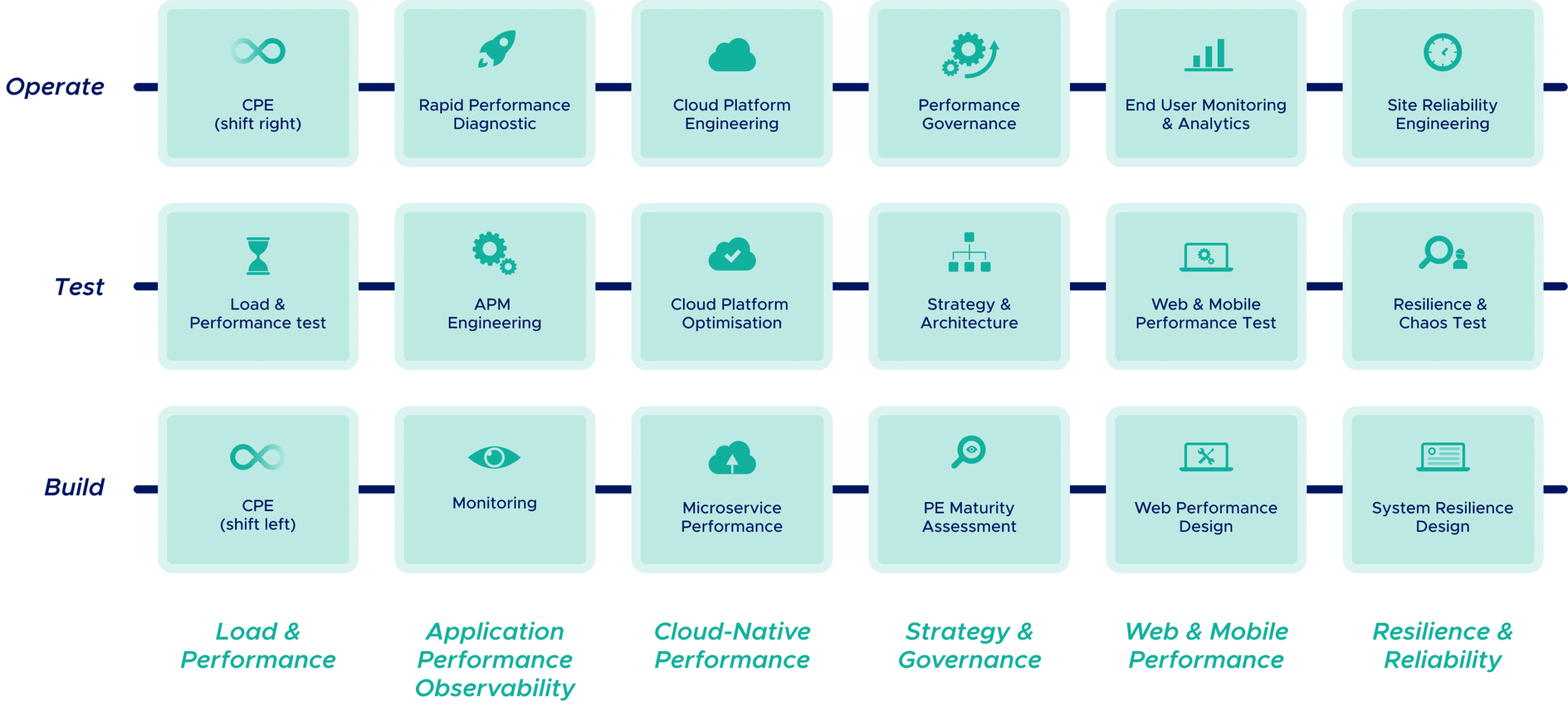
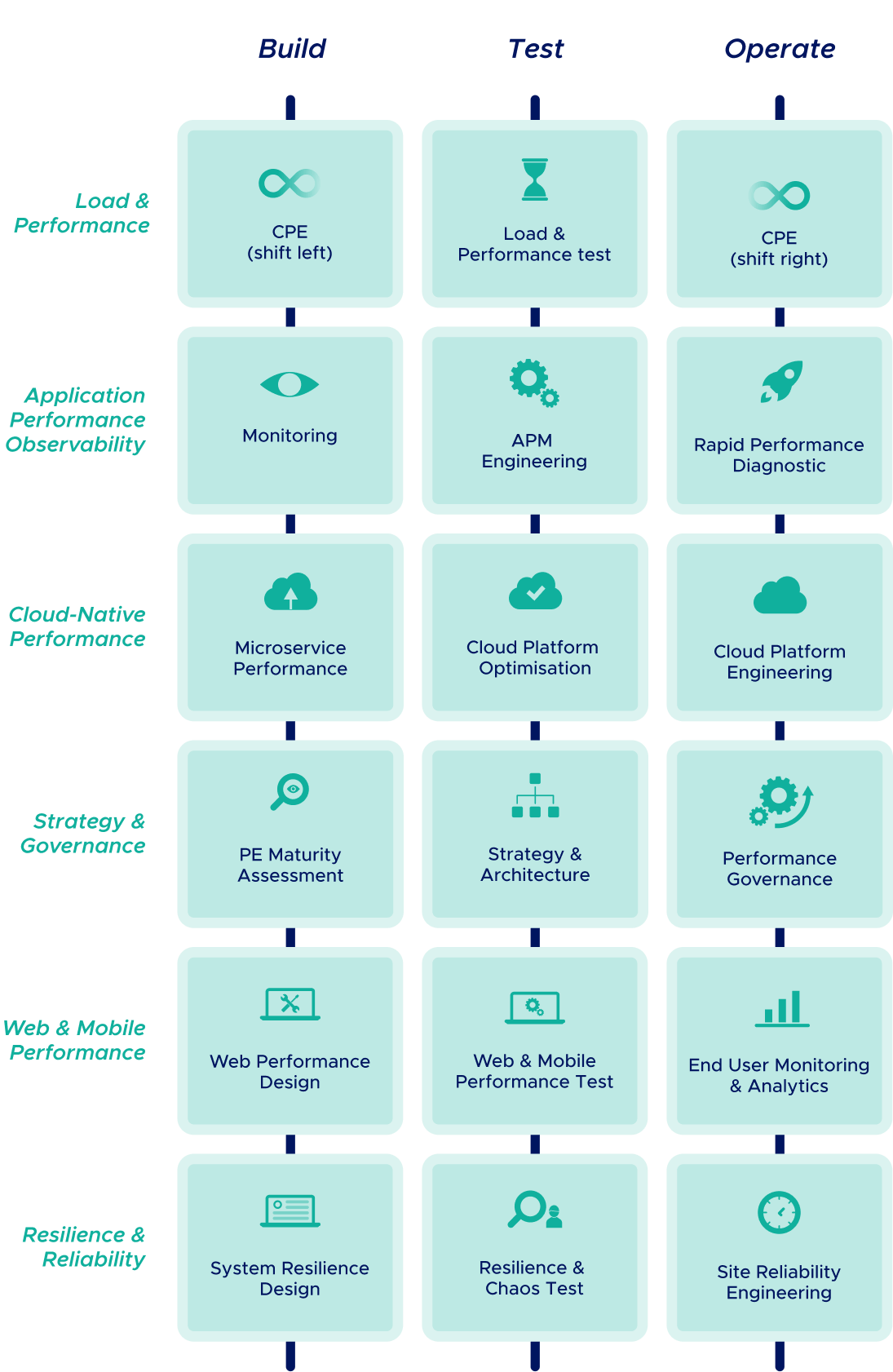
Let's find the missing piece for your project
Qim info, your partner in IT performance

Our Expertise
For over 20 years, our team has successfully resolved IT issues on over 2000 projects. We are committed to adapting to your unique requirements and constraints, to provide you with solutions that are tailor-made and effective.

Our Specialisation
With over 40 performance engineering experts, our department demonstrates the precise nature of our specialisation. As your trusted partner, we are committed to ensuring the operational excellence of your IT systems.

Our Holistic Approach
Our methodology covers the entire lifecycle of your applications. From requirements modelling to software optimisation, we offer comprehensive management, to maximise your applications’ performance and stability.
Let’s talk it over together
Let's find the missing piece for your project together
Qim info, your partner in IT performance

Our Expertise
For over 20 years, our team has successfully resolved IT issues on over 2000 projects. We are committed to adapting to your unique requirements and constraints, to provide you with solutions that are tailor-made and effective.

Our Specialisation
With over 40 performance engineering experts, our department demonstrates the precise nature of our specialisation. As your trusted partner, we are committed to ensuring the operational excellence of your IT systems.

Our Holistic Approach
Our methodology covers the entire lifecycle of your applications. From requirements modelling to software optimisation, we offer comprehensive management, to maximise your applications' performance and stability.
Sectors of Activity
Our department has worked on over 2,000 projects across various sectors
Health
Luxury
Watchmaking
Banking
Aeronautics
Insurance
Trading
Public administration
Our experts by your side
Since 2002, the Altersis Performance teams (now part of Qim info) have been successfully solving their customers’ IT system problems.
Our mission is to guarantee the stability and performance of your applications at every stage of their development and lifecycle.
With this goal in mind, each expert in our department has detailed specialist knowledge about performance engineering, and can provide you with tailor-made, cutting-edge solutions. Today, we are proud to be leaders in our field, providing the excellent service our clients have come to expect.
Choosing Qim info means benefiting from custom solutions. Our six departments work closely together to offer comprehensive support tailored to each specific need.

Morsi Tlili
Head of Performance & Observability
Use Cases
Concrete examples of success thanks to Qim info
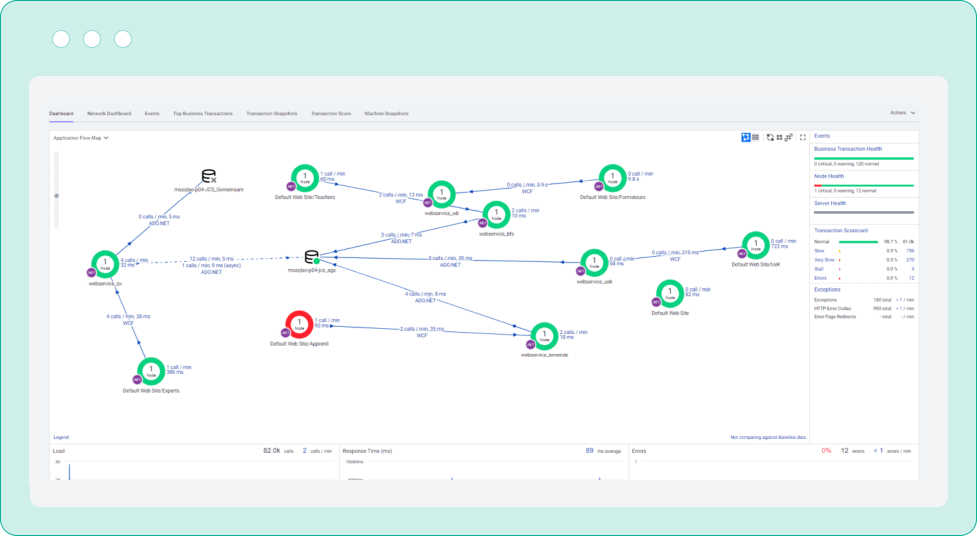
Solving performance problems that impact the citizen experience
Qim info worked with the administration of a Swiss canton. The digitization of public services required the implementation of an end-to-end monitoring solution to guarantee a good citizen experience. Our team conceptualized and implemented an APM solution, then onboarded 13 key applications and trained the local team in the use of APM. Following our intervention, dashboards with intelligent alerts and rapid diagnostic capability were up and running. Monthly reports including application performance results and relevant recommendations are delivered to application managers on a regular basis.
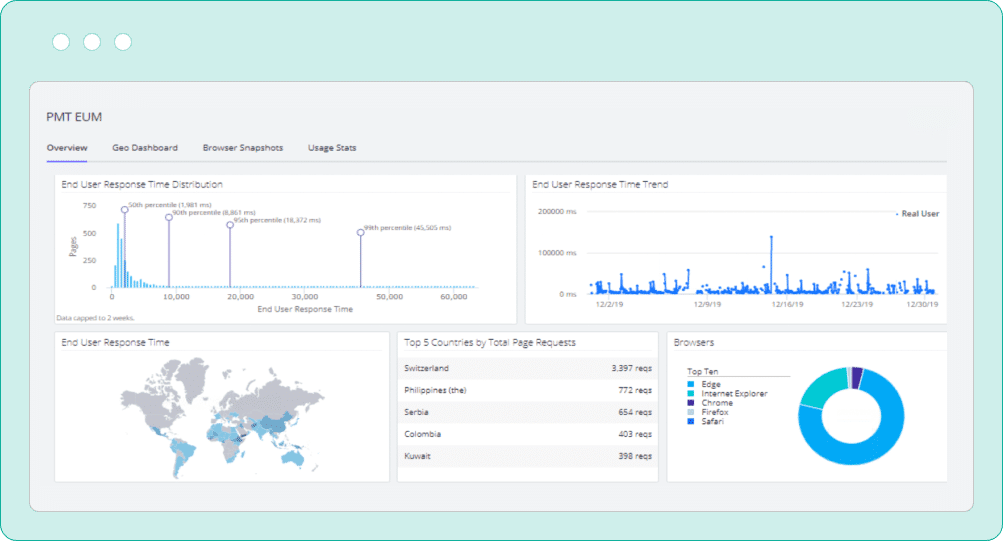
Successful latency resolution
Qim info worked with a humanitarian organization present in 80 countries, with +600 applications and +300 sites. Performance is critical to our customer’s business, especially for applications accessed from sites where high latencies are generally experienced due to poor network connections. These problems were leading to reduced productivity and high maintenance and downtime costs. To remedy these difficulties, our team deployed the AppDynamics APM (Application Performance Management) tool to provide end-to-end monitoring. 8 key applications were monitored by the APM, providing clear visibility of performance. The performance dashboards and intelligent alerts we configured enabled our customer to speed up the identification and resolution of the causes of performance problems.
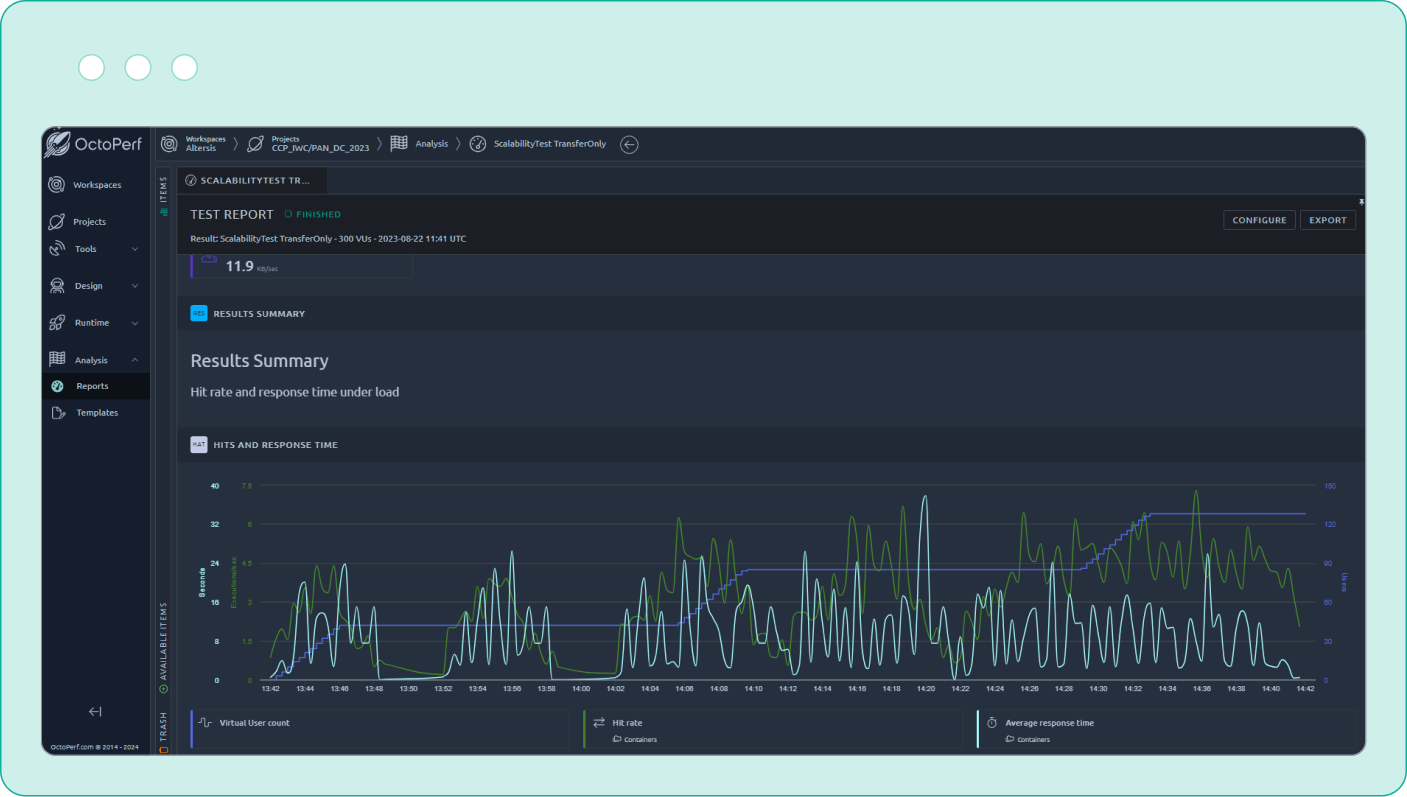
Successful implementation of L&P tests and APM operations
Qim info worked with a Swiss luxury goods company. As the complexity of its e-commerce applications increased, performance and availability became increasingly critical to our customer’s business. This meant regular testing of the applications under a representative load between releases and before each production rollout. We supported the customer in implementing performance tests using the Octoperf tool for the most critical applications. Our certified experts in monitoring and load testing solutions ensured a good user experience following production deployment.
Testimonial
"With Altersis Performance By Qim Info, we found a real partner for investigating, analysing and resolving complex performance issues. The Altersis Performance consultants not only support the investigations but also propose solid solutions for improving or fixing the issues in a professional and efficient manner. In addition, we know that in the long run, we can rely on Altersis Performance to propose a reliable approach to detecting issues early in the solution testing cycle, and to address them before we go live, thus improving our operational efficiency."

Partners
Our Partners and Tools


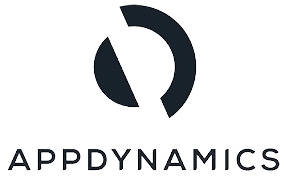
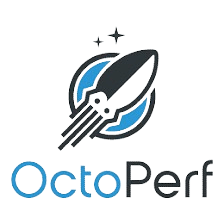



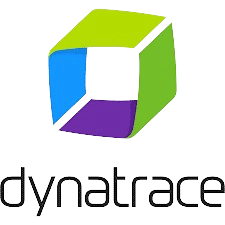







F.A.Q.
Your Questions, Our Answers
We understand the challenges associated with budgetary constraints. That’s why our solutions are flexible and can adapt to tighter budgets, including open-source software. Our goal is to offer you high-performance solutions, without finances becoming an obstacle to your success.
Although we have recognised expertise in the banking, insurance, public administration, and luxury sectors, our solutions are designed to be adaptable. Each project is an opportunity to demonstrate the versatility and efficiency of our solutions. That’s why we are excited to collaborate on different missions, regardless of your industry.
If you already have a monitoring solution, we will complement and enhance what you have already implemented. We offer in-depth expertise that goes beyond simple monitoring. It includes identifying optimisation opportunities, detailed recommendations for improving performance, and integrating load testing and continuous evaluation. Our approach aims to ensure optimal and sustainable performance of your systems, thereby increasing the added value of your existing infrastructure.
Our Rapid Performance Diagnostic offering is the answer to such situations. A quick intervention lasting 10 to 15 days should suffice to put your production platform under end-to-end supervision, using an APM tool. Detailed analysis and efficient troubleshooting will allow us to isolate the main causes of performance issues and provide you with a list of relevant recommendations on how to address latency and unavailability problems.






